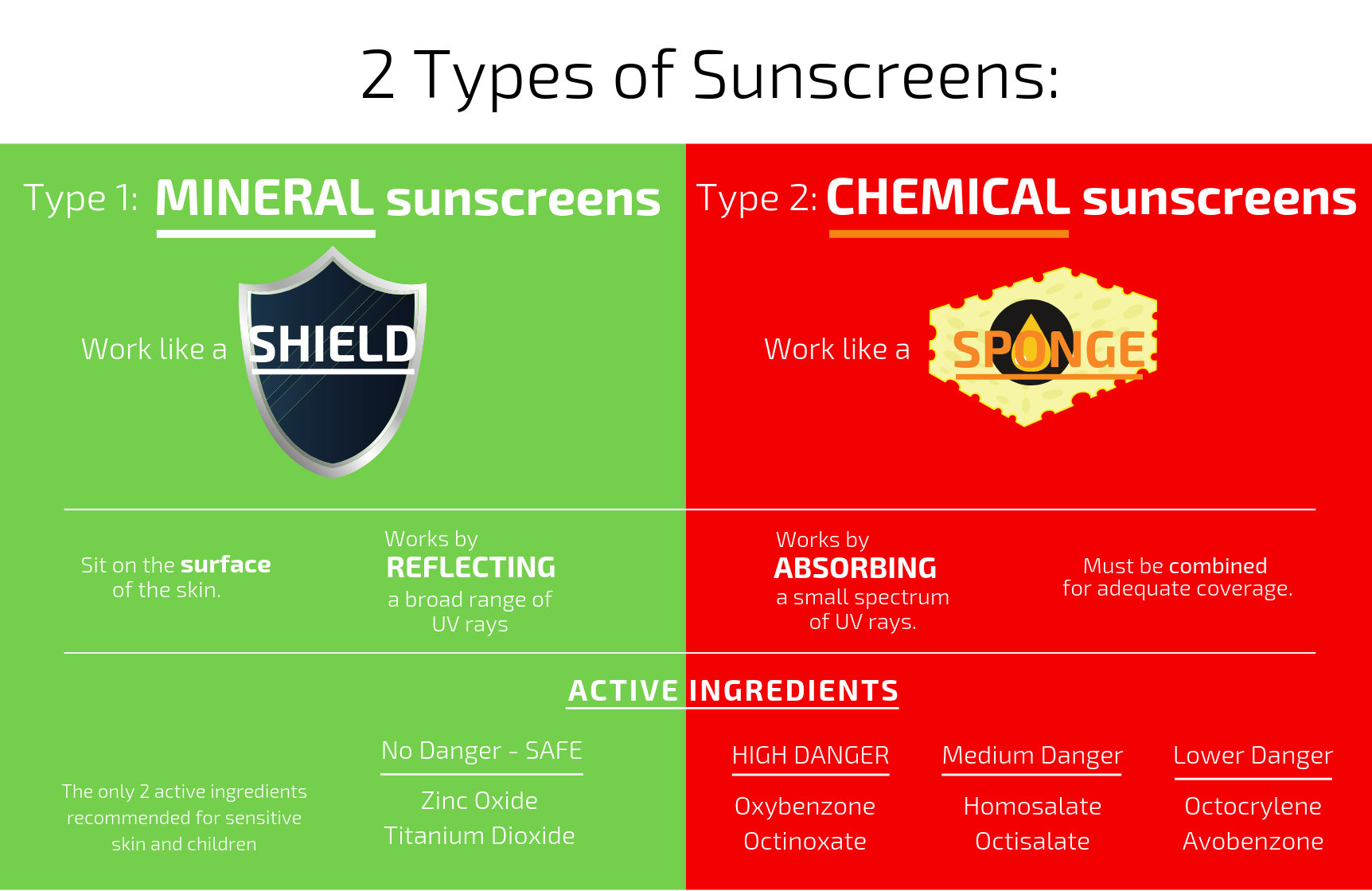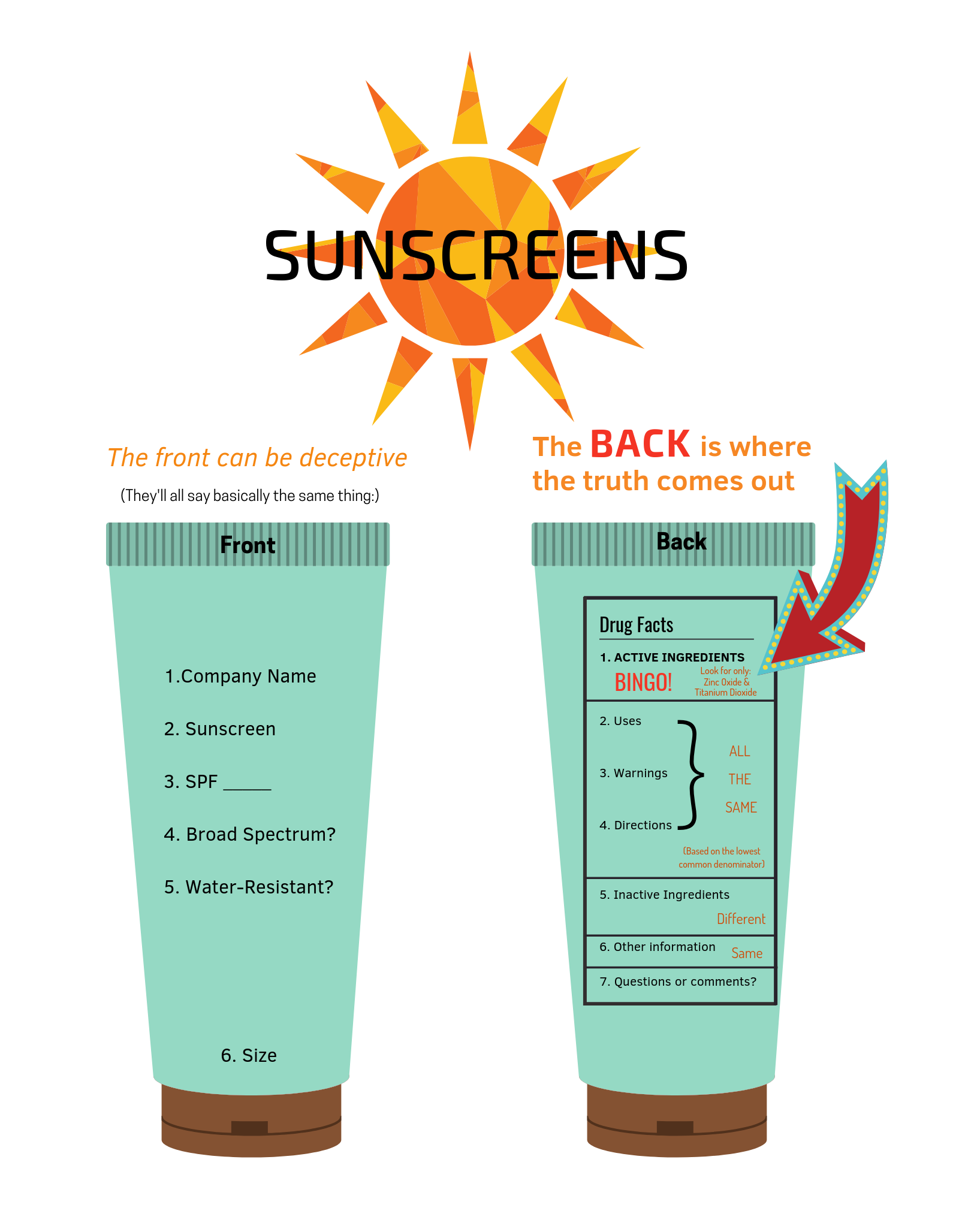Is Your Sunscreen Safe?
Sunscreen has been in the news a lot lately, with concerns over absorption of chemical UV filters.
Many people are starting to ask, “Is My Sunscreen Safe?” and it can feel like a complex minefield trying to figure it out.
It’s easier than you think.
First, a VERY IMPORTANT distinction must be made:
We can no longer call sunscreen simply “sunscreen” any more.
There are 2 types of sunscreens and it makes a BIG difference which you use.
The two types of sunscreens are completely different in their origins, behavior, consistency, stability, and reactivity. Each behaves differently on the skin and when exposed to the sun.
This warrants a change in perspective:
Clearly, there are two very different types of products, both acting to reduce sunburn. But one REFLECTS the sun’s rays, while the other ABSORBS the sun’s rays.
A QUICK BREAKDOWN:
CHEMICAL SUNSCREENS
Man-Made Chemicals
Act like a SPONGE
Most get ABSORBED in the skin (to the blood, and pass through the placenta and mothers’ milk)
Work by ABSORBING a small spectrum of UV rays.
Because each chemical UV filter only absorbs a tiny range of UV rays, many chemical filters must be COMBINED to reach any sort of adequate protection. (You can see the chart of chemical filter absorption ranges below).
Furthermore, many chemical UV filters (such as the best chemical UVA absorber Avobenzone) are highly unstable, so they must be combined with other more stable molecules to actually be effective - especially when exposed to sun exposure (which breaks down many chemical UV filters). Then we have issues with the ultra-stable chemical filters like oxybenzone that only degrades when metabolized.
Have been used for less than 40 years.
More oily, easy to spread
Many are highly reactive with the sun / their inherent chemical structures lead them to release free radicals when exposed to the sun — they literally work by causing chemical reactions on your skin and releasing free radicals as a by-product.
Many cause allergies / allergic reactions / long-term negative health effects
Extensive damage caused — hormonal and environmental — often these consequences don’t manifest themselves until the second generation, (ex. skewed birth ratios, feminization, birth, gender, and reproductive defects) so it can take 30-40 years to start figuring it out…
Many have toxic breakdown products (ex. oxybenzone is metabolized into BP-1, which is 5X more toxic than oxybenzone (BP-3)).
MINERAL SUNSCREENS
· Come from the Earth, Nature, Natural
· Act like a SHIELD
· Sit on the SURFACE of the skin
· Work by REFLECTING a wide range of the sun’s rays.
· Zinc Oxide is by far the best and most effective UV filter that exists. It can be used alone or coupled with Titanium Dioxide to provide more sleek, complete coverage. These are all you need for safe and complete coverage.
· Ultra-Stable - they are minerals that do not degrade in sunlight, and will retain their efficacy.
· The most safe and most effective UV filters.
· Have been used safely for hundreds of years for sun protection
· Tend to be more white & pasty (now micronized ZiO & TiO2 have boosted cosmetic elegance)
· Stay stable in the sun, don’t cause chemical reactions on your skin
· No allergies, negative effects, reactions to these natural filters
· These on their own cannot cause damage to the environment (note: avoid nano-particles)
· No toxic breakdown products
SUNSCREEN WAS NOT ORIGINALLY MEANT TO BE USED EVERY DAY
Sunscreen was created as a device to reduce sunburn.
As a device to reduce sunburn mainly when on vacation or at high altitudes.
When sunscreen use started, people were using sunscreen only on vacation, and were using minimal amounts. It was regulated with this intention.
The FDA proposed to regulate sunscreens in 1978, less than one year after Kumakari et al. discovered that UVA rays also had a negative impact on the skin. (This is only 3 years after Franz Greiter introduced SPF as a measure of sunburn protection factor from UVB rays.)
With this, the FDA regulated sunscreens as a minimally-used measure to protect solely from sunburns.
As time went on and we started to learn more about the sun and its damage to our skin, sunscreen use changed. [But regulation didn’t].
There are far more rays to worry about than just UVB rays (which are blocked by glass and vary with seasons and location). UVB rays make up less than 1% of total solar radiation.
UVA rays are far more prevalent than UVB rays, are ever-present, and penetrate deep within the skin’s surface, causing long-term damage such as aging and skin cancer.
YET, SPF HAS NOTHING TO DO WITH UVA RADIATION — IT ONLY REPRESENTS UVB (BURNING) RAYS.
Now, dermatologists recommend for everyone to wear sunscreen every day.
(Remember: there’s a big difference in the TYPE of sunscreen that you’re using!!!)
With sunscreen use on the rise, concerns are mounting over the absorption of many sunscreen chemicals, and the effects they could have.
MANY SUNSCREEN CHEMICALS ARE RAPIDLY ABSORBED.
Over the past 20 years, we have been learning more about these new sunscreen chemicals, and their long-term effects.
As sciences advances, we're able to better evaluate chemicals, chemical compositions, and recognize relationships.
By way of their chemical composition, some chemical UV filters are inherently absorbed (for example, oxybenzone with a molecular weight of 228 daltons) by the skin.
In minimal concentrations, this should not be a problem.
But now, we have astronomical concentrations, with tens of millions of pounds of sunscreen chemicals being produced each year, for application on our bodies, ideally on a daily basis.
More of these chemicals are being absorbed, and concentrations are rising in us and the environment.
Marine life is always the first signal of what is happening. We get cues from what is happening in wildlife, often demonstrating sooner the damage we’ve done.
Humans are less immediately impacted by the effects than smaller organisms, which is why science always calls on nature for clues and answers.
Nature has been clearly demonstrating the effects of some of these chemicals for years; we’ve been slow to wake up.
We now have decades of scientific data.
Hundreds of years of use of the mineral filters, and nearly 40 years of use of the chemical filters.
ONE THING IS CLEAR:
MINERAL FILTERS ARE SAFE AND EFFECTIVE.
The chemical filters, on the other hand, require more explaining.
The FDA is in the midst of changing their sunscreen rules for the United States this year.
It’s been proven that zinc oxide and titanium dioxide are (the most) safe and (the most) effective UV filters.
They are what dermatologists have been recommending for decades, and the only filters dermatologists recommend for sensitive skin and children.
With over a century of evidence and firm global scientific consensus that zinc oxide and titanium dioxide are safe, the most effective, and the only ones that should be used on sensitive skin or children, the FDA can easily make the determination that:
ZINC OXIDE AND TITANIUM DIOXIDE ARE
GENERALLY RECOGNIZED AS SAFE AND EFFECTIVE
(GRASE)
The problem, however, comes with the chemical filters:
IN THE UNITED STATES, CHEMICALS ARE CONSIDERED “SAFE UNTIL PROVEN OTHERWISE.”
Undeniably, this has massive implications.
Especially in humans, it is really hard to PROVE that a single chemical is the cause of specific outcomes dangerous enough for the chemical to be reclassified as unsafe.
There are too many other factors, and scientists cannot “scientifically” make this conclusion. (Only in animal studies can they come to such conclusions).
This has led to a huge lag in any policy shifts and public discourse on the matter… until recently (largely due to our precious coral reefs exhibiting the symptoms and consequences of some chemical filters - namely oxybenzone).
Now, the FDA is calling on companies to prove that these chemicals are safe, before we continue to unwittingly put millions of pounds of these chemicals on our skin and in our waters.
Until then, the important question:
While we tend to look at the front to determine which sunscreen to buy,
THE BACK is really where the truth comes out.
Often times, chemicals like oxybenzone and octinoxate can lead to higher SPF levels, but that doesn’t mean they’re more safe!
Flip your sunscreen over and look at the ACTIVE INGREDIENTS.
In the United States, we’re lucky because the FDA requires companies to clearly label their active ingredients at the top of the Drug Facts panel on every tube of sunscreen. This allows users to clearly identify the safety of their sunscreen.
LOOK FOR:
1. Zinc Oxide
2. Titanium Dioxide
STAY AWAY FROM:
1. Oxybenzone
2. Octinoxate
MANY CHEMICAL INGREDIENTS ARE ABSORBED
Some more rapidly than others.
The most concerning sunscreen active ingredient is oxybenzone.
Here’s a quick overview of some of the sunscreen ingredients and their proven scientific effects:
Check The Back!!
SPF is deceptive in seeing the quality & safety of your sunscreen.
Check the active ingredients on the back instead!
The active ingredients section will be at the top of the drug facts label (in the U.S.).
Look for ONLY: zinc oxide and titanium dioxide.
Stay away from!: oxybenzone and octinoxate, and it is safer to stay away from all chemical UV filters. (The ingredients listed in the table above)














